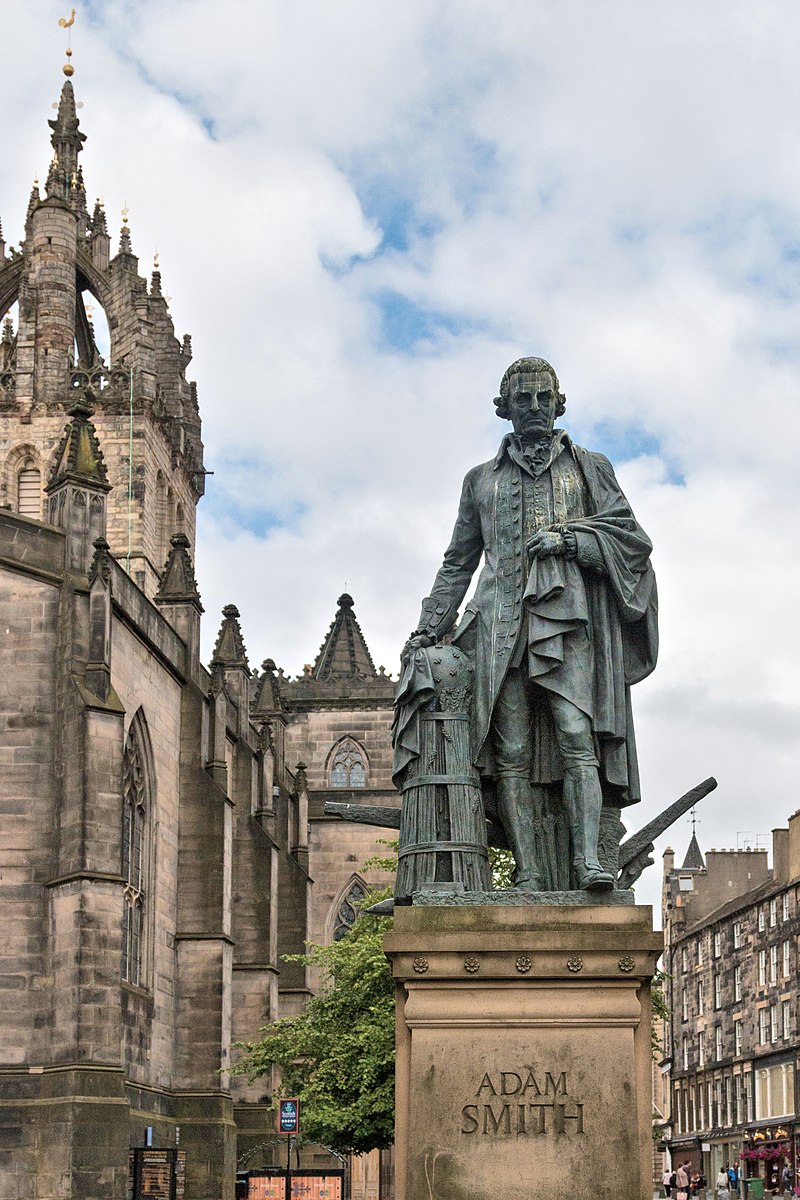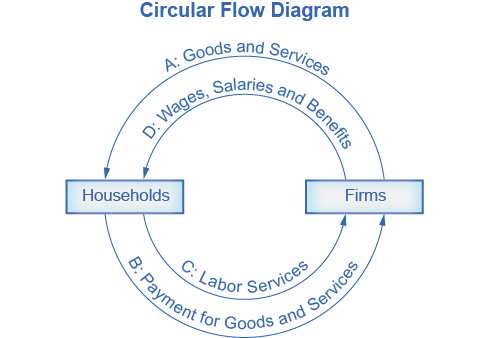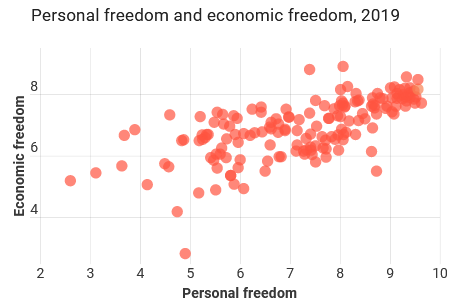Introduction to Economics
The roots of education are bitter, but the fruit is sweet.
—attributed to Aristotle by Diogenes Laërtius
Overview
Discuss the importance of studying economics
Explain the relationship between production and division of labor
Evaluate the significance of scarcity
Core Concepts
- Economics
the study of decision making in the face of scarcity
- Decisions
individual, family, business or societal.
- Scarcity
the desire for goods, services and resources exceeds availability.
- Resources
land, labor (time), capital (tools, equipment, buildings), human capital
limited in supply
used to produce goods and services
Introduction to FRED
- Economic data
describe and measure the economics concepts
- FRED
Federal Reserve Economic Data
online display as tables or charts
easily downloadable
Video: What Is FRED?
Coping with Scarcity: Two Options
each produces everything s/he consumes
“jack of all trades, master of none”
each produces something and then trades for consumption
division and specialization of labor
described by Adam Smith in The Wealth of Nations (1776)
pin manufacturing example (18 distinct tasks)
Adam Smith, 1723–1790

Adam Smith
Source: Stefan Schäfer
Productivity and the Divison of Labor
Benefits from:
current competency: specialization according to skills, talents, and interests
acquired competency: specialization -> quicker learning
economies of scale: larger organization size -> lower costs per unit
Costs from:
resulting need to trade
Why Learn Econ?
understand the world
critically evaluate arguments - when is “common sense” actually nonsense?
promote good policy (e.g., when voting)
but, “good” depends on your objectives
Micro vs Macro
- Microeconomics
Individuals and particular markets (e.g., determinants of the price and quantity of a good). Emphasize on constrained choice.
- Macroeconomics
The economy as a whole (e.g., determinants of inflation and unemployment). Emphasis on emergent outcomes.
Microeconomic Questions: Some Examples
how do individuals make trade-offs among goods and services?
how do individuals make trade-offs between saving and consumption?
how do firms decide what to produce and how?
how does a market determine price and quantity?
how do taxes affect the decisions of individuals and firms?
Macroeconomic Questions: Some Examples
what is the overall level of production in a society?
how is the overall level of production changing over time in the short run?
how is the overall level of production changing over time in the long run?
what determines the overall level of production?
how can we compare the standard of living across countries?
what determines the social distribution on income and wealth?
how do monetary and fiscal policy affect the economy in the short run and long run?
Theories and Models
What Is a Theory?
more than just an idea or hunch,
a system of ideas that helps us organize our interpretations of a system.
an explanatory framework for a domain of possible experiences.
- physical sciences
reserve the term ‘theory’ for hypotheses that are widely accepted due to the weight of the accumulated evidence
- social sciences
use the term ‘theory’ just to mean an abstract model plus a hypothesis
What Is a Scientific Theory?
a scientific theory generates scientific hypotheses.
- scientific hypothesis
observations must be able to affect the credibility of the theory
experience (observations) can force revisions to beliefs (about the accuracy of the theory).
If we are committed to a theory regardless of the evidence, we are not doing science. A scientific theory is vulnerable to the evidence.
Systems and Models
- model
characterizes a real or imaginary system, known as the target system.
- system
an object or process with components, along with
the structure of their interrelations.
Model Development
- Model development
efforts to conceptualize, implement, or improve a model.
- ignores many real-world features
some are too costly to consider
some are judged to be irrelevant (to the model-development goals)
Model Development Process
Sometimes model development is purely verbal or graphical.
However, scientific model development often involves implementing the conceptual model as a mathematical model, computational model, or physical model.
Figure f:modelingProcess100 provides a stylized illustration of key steps in model development and analysis.
Stylized Representation of Modeling Process
Questions about Modeling
A “good” model helps us achieve the goals we had when creating it.
understand
predict
control
The usefulness of a model should be assessed in terms of its goals.
A pedagogical model may aid understanding without being useful for prediction.
A statistical model may help predict without adding much understanding.
A more realistic model need not be a more useful model.
Related question: what makes a map useful?
Can a map of Middle Earth be useful?
Two Camps: RAD vs. KISS
- Realism, Accuracy, and Detail (RAD):
realism is a virtue
create accurate and detailed representations of relationships
closer resemblance to nitty-gritty empirical investigations
- Keep it stylized and simple (KISS):
simplicity is a virtue
create highly stylized representations of relationships
closer resemblance to formal mathematical theory building
Simplified Circular Flow Diagram for the Macro Economy
Economic models often highlight interactions between different parts of the economy.

Circular Flow
Households and firms interacts in the markets for goods and services and in the labor market.
(Keeping it very simple!)
Video: Simplified Circular Flow Diagram
Video from the St Louis Fed (Economic Lowdown)
Epstein on Why We Model
[Epstein-2008-JASSS] offers 16 reasons other than prediction.
Explain (very distinct from predict)
plate tectonics and earthquakes; electrostatics and lightning; evolution and speciation
Guide data collection
Illuminate core dynamics
Suggest dynamical analogies
Discover new questions
Promote a scientific habit of mind
Bound (bracket) outcomes to plausible ranges
Illuminate core uncertainties.
Epstein on Why We Model (cont.)
Offer crisis options in near-real time
Demonstrate tradeoffs / suggest efficiencies
Challenge the robustness of prevailing theory through perturbations
Expose prevailing wisdom as incompatible with available data
Train practitioners
Discipline the policy dialogue
Educate the general public
Reveal the apparently simple (complex) to be complex (simple)
Economic Systems
Economic Systems: Traditional Economy
occupations stay in the family
most families farm traditional crops
produce what you consume
little economic progress or development
Economic Systems: Command Economy
government sets production goals and methods of production
government sets prices and wages
government may set low or zero prices on “necessities” (e.g., healthcare, education)
Examples: Pharonic Egypt; Medieval manor life
Examples: Cuba and North Korea have large command elements to their economies.
Economic Systems: Free-Market Economy
decentralized production decisions (private enterprise)
market supply and market demand determine prices and wages
even “necessities” (e.g., healthcare, education) are priced by the market
Economic Systems: Mixed Economy
most actual economies
combine market and command elements
entire spectrum from primarily free market to primarily command
likely subsidy of some “necessities” (e.g., basic healthcare, K12 education)
Personal and Economic Freedom

Personal and Economic Freedom
Source: Cato
Rules of the Economic Game
Reliable rules reduce risk and uncertainty.
The rules of the game include:
- laws protecting person and property are part of the rules of the game - laws enforcing contracts are part of the rules of the game - regulations are part of the rules of the game
- regulations can
promote competitive innovation (e.g., anti-trust)
or inhibit competitive inhibit (e.g., excessive patenting)
References
Coen, Corinne. (2009) Contrast or Assimilation: Choosing Camps in Simple or Realistic Modeling. Computational and Mathematical Organization Theory 15, 19--25. http://www.springerlink.com/content/mt3177867j468308/
Epstein, Joshua M. (2008) Why Model?. Journal of Artificial Societies and Social Simulation 11, Article 12. http://jasss.soc.surrey.ac.uk/11/4/12.html